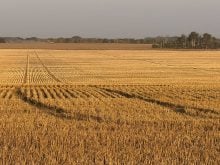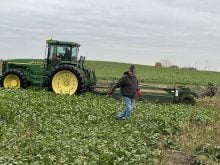It’s a question wildlife ecologists, farmers and environmentalists have been asking for years.
This winter, it was answered by one small bird.
A burrowing owl, banded in Saskatchewan, was found last December in southern Texas near the Mexican border.
“We’ve long suspected that’s where they go,” said Karyn Scalise, a wildlife ecologist with Saskatchewan Environment and Resource Management who co-ordinates research activities. “This is the first confirmation.”
The discovery of one small owl is a big step forward in finding out why the population is dwindling. The burrowing owl is an endangered species.
Read Also

U.S. government investigates high input costs
The USDA and DOJ are investigating high input costs, but nothing is happening in Canada.
Scalise and others have been looking for answers in the owls’ summer home on the Regina-area plains, in part because they didn’t know where the birds wintered. Operation Burrowing Owl focuses on increasing the bird’s numbers through artificial nest boxes and supplemental feeding, with the co-operation of landowners, who monitor the birds.
Populations continued to decline, tapering off at a one percent decline a couple of years ago. But the number of breeding pairs returning in 1997 dropped by 35 percent, which seemed to indicate big problems in the wintering grounds, Scalise said.
She hopes a new program, the TransAmerica Migratory Bird Fund, will help by educating people outside Canada about the importance of the owls’ wintering habitat and by providing that habitat through land management programs.
“I would love to see a private stewardship program all the way along” the birds’ migratory route, she said.
This spring more owls are back than last year, marking the first time since 1987 that the population hasn’t declined, she said.
Research will continue to look at post-fledgling ecology. Scalise said 50 percent of fledglings die before they migrate because of predators, collisions with vehicles and loss of habitat.
“We know food shortage can be a very serious problem in some years,” she said. Research found that twice as many fledglings survived when they received supplemental feeding.
One project this year will involve the first release of owls raised in captivity. While not part of the present management strategy, Scalise said the release techniques will be examined in case it ever becomes necessary.
Banding and tracking the birds will also continue. Of 3,000 banded owls, only 10 were ever recovered and nine of those were in spring or fall, Scalise said.
Last year, transmitters were put on 12 birds and researchers followed them in a small airplane. Two signals were picked up as far away as Dickinson, North Dakota, but the project hit a snag because the researchers were prohibited from flying at night – when the owls are in flight.
“We did find they were flying 186 kilometres a night,” Scalise said. “That’s a lot more than we thought.”
She said the transmitter frequencies will be passed on to agencies in the United States and Mexico.















